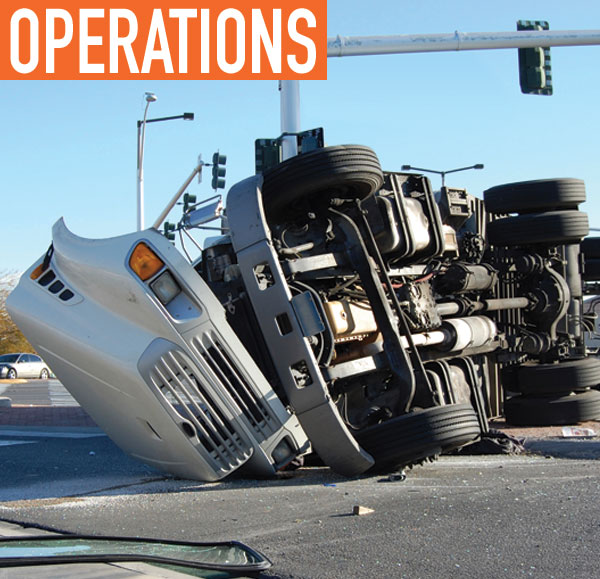While work truck fleets scramble to save money by extending vehicle lifetimes, “right-sizing,” planning more efficient routes, and increasing fuel economy, they may be overlooking other opportunities that could save them hundreds of thousands to more than a million dollars a year. One opportunity warranting a closer look is partnering with a third-party fleet driver management company.
Fleet driver management firms offer a combination of services aimed at preventing accidents, reducing repair costs for collisions that still occur, and improving fleet recovery of accident damages from at-fault, third-party drivers. Let’s look at each of these services and how much they can cut net fleet costs.
ACCIDENT PREVENTION
While it’s unlikely that there will ever be a day when our highways are accident-free, it is possible to achieve dramatic reductions in fleet accident rates by adopting systems that have been proven to change driver behavior. The good news is that this is where work truck fleets can generate the greatest savings on accident-related costs.
Let’s start by taking note of what the average fleet accident costs. The truth is, it goes way beyond the cost of repairing or replacing a damaged vehicle. The typical expense to repair a vehicle that’s still drivable is below $3,000; to repair one that has to be towed is around $5,000. But the company or government that sponsors a fleet incurs greater costs that fleet departments may not track, including claims and higher premiums for workers’ compensation and health care insurance, lost productivity, and legal and related administrative expenses.
In fact, the Network of Employers for Traffic Safety (NETS) estimates that the average total cost of a fleet accident is around $16,500, but much more when somebody’s hurt; the average total for one involving a non-fatal injury is more than $76,000 and more than $504,000 for one involving a fatality. NETS also calculates that accidents cost a 500-vehicle fleet with a 20 percent fleet accident rate (or 100 accidents) roughly $1.65 million a year.
The good news is that the best fleet driver management companies offer online safety applications that have helped fleets reduce their annual accident rates by as much as 35 percent. For a 500-vehicle fleet, that could mean 35 fewer accidents with avoided expenses of more than $500,000, of which only $100,000 to $180,000 represents repairs that weren’t needed.
Now, we’re not talking about on-board collision-avoidance safety systems, which compensate for or warn drivers about errors that make a crash imminent. Instead, the application that a fleet driver management company offers aims at changing drivers’ behavior to make them more careful drivers. It works by collecting data that describes every fleet driver’s behavior and sorting drivers into ascending risk categories based on points for bad behavior. The data includes such things as convictions for traffic violations as recorded on motor vehicle records (MVRs), traffic camera violations, recent accident history, and data from public driver reporting services and telematics systems.
As soon as a fleet driver accumulates enough points to ascend to a higher risk rating, the application automatically sends an email to the driver that notifies him of his increased risk score and assigns remedial safety training that’s completed either online or behind the wheel. It also sends copies of the email to the driver’s manager, the fleet manager, safety manager, human resources, and the legal department, depending on decisions the fleet makes in advance.
In essence, a fleet driver safety application is a virtual fleet safety committee that delivers timely consequences to drivers for bad behavior. As drivers become aware that they no longer fly under the radar, they tend to correct their future behavior and become better drivers. The key benefit is that these systems identify high-risk drivers, often before an accident occurs, and create a record of fleet interventions that can increase the fleet’s protection against liability for any future accident.

NETS estimates that the average total cost of a fleet accident is around $16,000, and could be more than $504,000 if the incident involves one fatality.
REPAIR SAVINGS
When accidents occur, a fleet driver management company handles the repair. Once a driver or fleet manager contacts the company, it assigns the vehicle to a nearby repair shop that is part of the firm’s managed network of collision repair centers. The best companies employ an in-house team of experienced, licensed physical damage appraisers who scrub every estimate for potential savings on parts and labor. A team of expediters assure that the repairs are completed on schedule. The result can be savings of as much as 8-12 percent, not just on the repairs themselves, but as a result of lower rental replacement vehicles due to a shortened repair cycle.
LOSS RECOVERY
The third key service offered by fleet driver management companies is loss recovery, also known as “subrogation.” They can find recovery potential in one out of every four claims and collect up to 95 percent of the funds pursued. This includes not only repair costs, but reimbursement for loss of vehicle use and diminished market value. If you’re spending $250,000 a year for collision repairs, that could mean offsetting $50,000 of it or more by receiving checks on behalf of at-fault, third-party drivers.
Loss recovery is a paralegal activity that often frustrates fleet managers who try to handle it on their own. The laws as to how much can be recovered vary from state to state, and drivers and their insurance carriers employ a number of tactics to try to make it difficult to recover one red cent. As a result, fleets across the country are leaving tens to hundreds of millions of dollars uncollected every year. Considering that fleet driver management companies only get paid when they collect, their loss recovery services pay for themselves several times over.
Fleet driver management companies represent an opportunity for fleets and their sponsors to achieve additional, significant savings they may not have realized were available. What’s more, they leverage fleet departments’ resources, leaving them more time to concentrate on their core tasks. It’s a potential win-win that work truck fleets owe it to themselves to consider.![]()
ABOUT THE AUTHOR:
Ken Latzko director of sales support and marketing of CEI, a provider of technology-enhanced vehicle accident, driver safety and fleet risk management services. For more information, please visit www.ceinetwork.com.
_______________________________________________________________________
MODERN WORKTRUCK SOLUTIONS: Preview Issue
Did you enjoy this article?
Subscribe to the FREE Digital Edition of Modern WorkTruck Solutions magazine.
![]()




